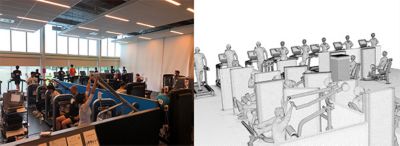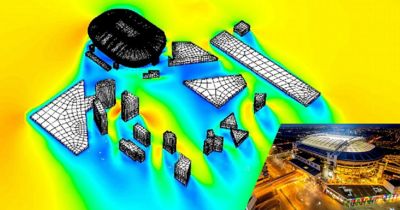-
United States -
United Kingdom -
India -
France -
Deutschland -
Italia -
日本 -
대한민국 -
中国 -
台灣
-
Ansys is committed to setting today's students up for success, by providing free simulation engineering software to students.
-
Ansys is committed to setting today's students up for success, by providing free simulation engineering software to students.
-
Ansys is committed to setting today's students up for success, by providing free simulation engineering software to students.
-
Contact Us -
Careers -
Students and Academic -
For United States and Canada
+1 844.462.6797
ANSYS BLOG
February 23, 2021
Winning the War on COVID with Ansys Fluent
Renowned researcher Bert Blocken, Ph.D., was recently recognized by Engineering.com alongside other pioneering minds, such as Elon Musk and Ansys CEO Ajei Gopal, for his groundbreaking academic research activities in computational fluid dynamics, wall function development and analysis of basic flow phenomena.
Blocken is a civil engineering professor at Eindhoven University of Technology in the Netherlands and at KU Leuven in Belgium. For more than 10 years, he has relied on Ansys simulation solutions, specifically Ansys Fluent, to solve highly complex engineering challenges that cannot be solved using traditional experimental research methods. Blocken’s research spans many fields, including built environment to minimize the impact of heat wave or pollution and sports, where he’s used Fluent simulation results to help Tour de France cycling teams develop new strategies for shaving seconds of their racing times and winning championships.
Research shows that gym patrons could exercise more safely within enclosed spaces that were sufficiently cleaned by combining ventilation and advanced air purification systems.
Blocken has also used Fluent in the fight against COVID, proving that standard social distancing guidelines aren’t enough when exercising outside. Through his previous work as part of Ansys’ ongoing battle against COVID, he reported that much more space is required to avoid potentially harmful droplets from nearby runners and cyclists.
In support of Blocken’s project, Eindhoven University of Technology was awarded a Microsoft AI for Health grant to power the simulations his group will be running. This grant is under the auspices of the COVID-19 High Performance Computing Consortium, which brings together global technology leaders to provide access to high-performance computing resources in support of COVID-19 research. Blocken’s team will use these credits to simulate their CFD models with Ansys Cloud, the gateway to Azure compute power for Ansys technology.
“Using Ansys technologies really helps me push boundaries in my academic work. I think that's the reason why my partnership with Ansys has lasted so long and actually why it's intensifying every year,” says Blocken. “It’s been an ongoing success story working with them and I’m very proud of this partnership.”
Recently, the Dutch government agencies Topteam Sports and Sportinnovator recruited Blocken to help citizens return to fitness centers, and some sense of normalcy, in the wake of the pandemic. Using Fluent, his research results showed how gym patrons could exercise more safely within enclosed spaces that were sufficiently cleaned by combining ventilation and advanced air purification systems. He has since leveraged that research to tackle an even bigger problem: reopening soccer stadiums and maximizing spectator capacity, even during the pandemic.
Opening Up Fitness Centers
Around the world, the pandemic has forced many fitness centers to close. The reason? When people perform physical exercise, they generate more saliva droplets, sending aerosol particles into the air. And that’s the worry. When people congregate inside rooms that aren’t well ventilated, particles continue to amass, creating concentrations so high where everyone inside the room could become infected.
Professor Bert Blocken used simulation to track the number of aerosol particles within the confined space of a fitness center.
Using Ansys Fluent, Blocken proved that existing ventilation systems are often incapable of efficiently removing these aerosol particles from the air. And this is particularly the case in fitness centers, where people are performing serious exercise, exhaling hard and generating many particles, but also inhaling many particles exhaled by others.
How do gym owners solve that? They could install a new ventilation system, but that would be very expensive. They could keep doors and windows open all the time, but during winter, they’ll have a very high energy bill because they still have to provide heat.
Recruited by the Dutch government to solve this challenging problem, Blocken used Fluent to track the number of aerosol particles within the confined space of a fitness center and examined how advanced air purifying machines could be used to ingest the aerosol particles and potentially eliminate contagion.
Topteam Sports in the Netherlands, appointed by the Ministry of Health, Welfare and Sport, commissioned Blocken and his team to study aerosol reductions in an indoor fitness center.
Blocken leveraged his thousands of hours of previous COVID simulation research, where he used Fluent to analyze airflow around human bodies and droplet dispersion in this airflow.
“Simulation turns the invisible coronavirus visible, giving architects, building designers and HVAC system engineers invaluable insights into what’s happening inside buildings and proving how their equipment is handling or not handling harmful particle concentrations. And by making the enemy visible, it’s easier to attack and annihilate it,” says Blocken. “I think we should count ourselves lucky that this pandemic didn't happen 20 years ago, otherwise we wouldn’t have powerful simulation software like Fluent and the required simulation hardware to properly tackle it and help save lives.”
Blocken is also using Fluent to test upscaled versions of these machines’ applicability for large stadiums, which could help soon pave the way for ensuring public safety at large sporting events.
Getting Fans Back in the Stands
Sports fans are excited to return to stadiums and see their favorite teams play again. In a large public-private partnership project co-funded by Health~Holland, Blocken is using the Johan Cruyff Arena, the Netherlands' largest stadium with more than 55,000 seats and home of the AFC Ajax soccer team, to model how a cheering crowd spreads aerosols through the air.
Weather conditions play a huge impact on how aerosols spread, so Blocken used Fluent to simulate numerous weather conditions for predicting aerosol particle concentrations and defining stadium capacity guidelines on game days.
Using Blocken’s Fluent results, together with input from virologists, stadium owners will select solutions that could reduce the concentrations, ranging from leaving certain stadium gates open to force more ventilation or, in extreme cases, installing air cleaning systems to eliminate aerosols in the spectator stands and inside stadium concourses.
The air purifying tech Blocken used to model fitness centers is being tested in Holland’s Johan Cruyff ArenA to make stadiums safer.
Equipped with this data, stadium authorities can confidently make the call to open at full capacity, limit capacity to a specific number of fans or delay the game until weather improves.
“We need Fluent to help prepare society for potential next waves of this virus, but also for future pandemics, because this will probably not be the last one that we will experience in our lifetime,” says Blocken. “The next time something like this happens, the economy needs to be ready and we should not have to close fitness centers anymore. Or anything else.”
If the world keeps accelerating its investment in modeling and simulation, the impact of the next pandemic could be minimum both in terms of deaths and its impact on the worldwide economy.
Take a deeper dive into Ansys Fluent. Be sure to check out the many Ansys Fluent articles, videos, white papers and webinars.














